How to clean your toilet yourself: the best ways to eliminate blockages
In the sewer system, blockages may periodically form, disrupting the normal passage of wastewater and waste. Agree, calling plumbing at the slightest malfunction in the toilet is not the best solution. Moreover, it is quite possible to eliminate most of the problems without a specialist. Doubt it?
We will tell you how to clean the toilet using home remedies or household chemicals. If these methods are powerless, you have to resort to a more effective tactic - mechanical cleaning of plumbing. Step-by-step instruction in its implementation is described in detail in the article.
In addition, we recall the measures for the prevention of sewer congestion, which will help to avoid the appearance of “traffic jams” in plumbing fixtures.
The content of the article:
Causes of Clogging
“Jams” in pipes can form for various reasons. Most often they arise due to clogging of the sewage with foreign objects.
This can happen if food waste, cat litter, rags, plastic bags, and feminine hygiene items are thrown into the toilet.
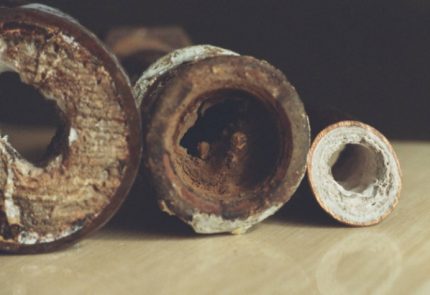
Negative effect on pipes lack of proper plumbing care. Without regular cleaning of the system, growths of urinary stone can form inside, which can narrow or even block the drain. Clogging can also be caused by salt deposits, which is typical for areas where hard water circulates in the water system.
Determining the type and place of clogging of the system
Before taking measures to clean the plumbing device, you need to determine the type of congestion, and also, if possible, find out where it is located. To do this, several simple manipulations should be performed.
First of all, you need to find out if the water gets into the sewer or the system is completely shut off. To do this, it is enough to pour about a liter of liquid into the toilet bowl, and after 30 minutes check its presence.
It is undesirable to use water from the flush tank for this, since in this case a large volume will be poured into the bowl - 3 l or more.
Even the slow seepage of water into the drain indicates that it is a fairly light blockage, which in most cases can be dealt with independently. If the liquid does not pass at all, a more serious problem is possible.
In this case, you need to check if there is a blockage in the local or central sewer system. To do this, open the taps of the remaining plumbing fixtures and see how the water drains.
If the liquid leaves as usual, then the congestion is most likely in the pipe at the outlet of the toilet. With a low drain in all devices, the problem can be in a common house sewer system.
Particular attention should be paid to the situation if waste comes up in the drain devices of a bathroom or sink. It is worth asking the neighbors about the condition of their plumbing - this problem may affect rooms located on the riser.
In the case of a positive answer, it is better to immediately call professional plumbers: most likely the “traffic jam” is located outside a certain apartment.
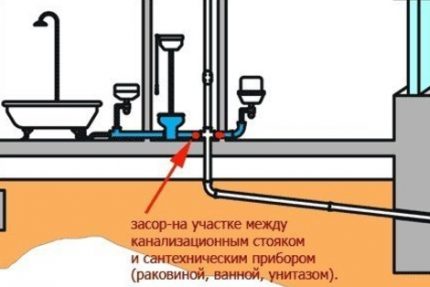
In almost all cases, blockages occur not on even sections of pipes, but on joints, bends, and transitions. It is these places that should first be examined, trying to find a "jam" in the sewer.
Below we look at the main ways to eliminate congestion.
Folk ways to get rid of blockages
To eliminate obstruction of the pipes, various substances can be used. First of all, you can try to clean the toilet by elementary methods.
Hot water and soda
To begin with, it’s worth trying the simplest option to eliminate the “cork” - to pour a bucket of hot water at a right angle. If the water begins to slowly go away, it is better to wait a while, and then pour another container of liquid. You can speed up the process with a plunger.
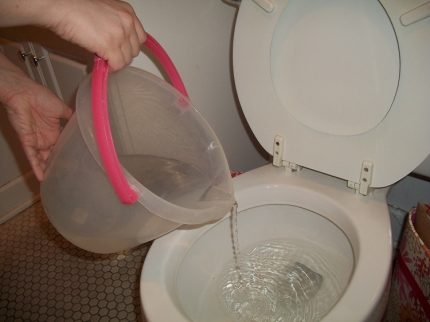
This method is good for congestion caused by drains into the sewer of small waste, such as a cat's wood toilet. To increase the efficiency of the method, you can add half a pack of soda to a bucket of hot water.
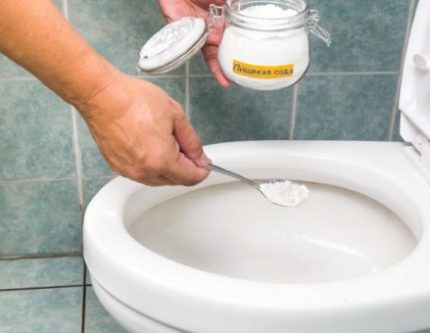
Soda will partially dissolve organic contaminants and fats, which will help to eliminate blockage.
Effective combination - soda + vinegar
You can apply a more complex option:
- Half a pack of baking soda is poured into the drain hole of the toilet bowl from which liquid is scooped, which must be pushed into the pipe as deep as possible.
- After that, 0.5-1 cups of vinegar is poured there (carefully!). It is necessary to wait for the end of the reaction, as a result of which gases are released that destroy the cork.
- After 20-30 minutes, 2-3 liters of boiling water or hot water are poured into the toilet (the latter option is desirable for toilets with fragile connecting corrugation).
With this simple method, it is often possible to eliminate light blockages in the shortest possible time. If it does not help, you can try using ready-made household chemicals.
Chemical blockage
On the shelves of specialized stores a large selection of preparations for cleaning the toilet. Their action is based on the ability of some components to dissolve the “plug” that clogged the sewer system.
A correctly selected product can completely or partially dissolve the blockage, due to which the normal functioning of the sewage system is restored.
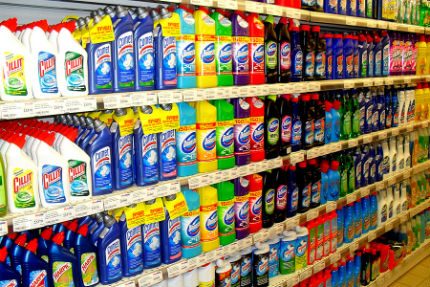
Household chemicals are available in the form of granules, powders, sprays, gels, liquids. The last two varieties have the most effective effect; moreover, gels cause minimal harm to human health.
As a rule, the active agent of all household chemicals designed to eliminate congestion is caustic soda, which copes well with organic substances. Other aggressive components that enhance their effectiveness are added to the composition of a number of drugs.
Chemical compositions are well suited for the elimination of weak and medium blockages, especially caused by organic substances.
These drugs are also good for preventive maintenance, as they:
- provide reliable disinfection of sanitary devices;
- maintain the sewer system in good condition, removing deposits of urinary stone, lime and other substances;
- extend the life of plumbing, pipes, systems.
It must be borne in mind, however, that household chemicals cannot cope with a clogged sewer caused by a plastic bag that is stuck in a pipe.
Home Remedies
To get rid of the blockage, chemicals are often used that almost every housewife has.
Congestion often try to clean by applying solutions of hydrochloric, formic, sulfuric acids. It should be remembered: working with such drugs requires caution, in addition, they are unsuitable for pipes and sewer systems made of cast iron.
Sometimes you can find a recommendation to eliminate congestion with a popular dishwashing detergent Fairy. This tool really effectively dissolves fat "plugs", freeing the pipe, however, this type of clogging is more common in the kitchen and is rarely found in the pipe leading from the toilet.
Experts also oppose the use of bleach solutions and agents such as "White" to remove blockages in the sewer. Such funds can prevent congestion with regular use, but they will not be able to break through it, in addition, they extremely negatively affect the human body.
Overview of specialized toilet cleaners
Consider the most popular tools.
Bagi Pothan. One of the most effective tools that are offered in our stores. The active components of the drug are caustic soda and surfactants that can eliminate even serious “plugs” in the sewage system.
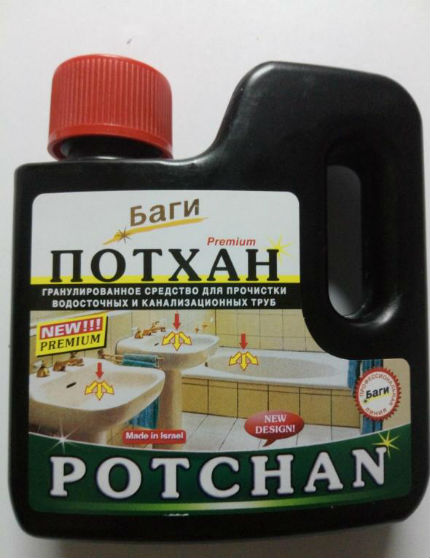
Advantages:
- instant result;
- profitability;
- convenient bottle with a nose;
- the presence of a lock cover that protects against children.
Disadvantages:
- fairly high cost;
- the product is sold only in large containers;
- the use of the drug in worn-out sewer systems is undesirable;
- if it comes into contact with the skin, mucous membranes can cause a chemical burn, therefore it is necessary to take maximum precautions while protecting hands, respiratory organs and eyes.
Method of application: drain the water from the bowl as much as possible, including the drain (at least 5 cm). Pour about 100 g of the product into the hole and wait 3 minutes, then pour a glass of hot water. Soak again for 3 minutes, then rinse the system well. When working, it is important to constantly ventilate the room.
"Mister Muscle". Gel or granules intended for the prevention and elimination of simple congestion.
Advantages:
- sufficient efficiency - copes well with organics, including hair;
- perfectly disinfects pipes;
- eliminates unpleasant odors.
Disadvantages:
- does not eliminate severe blockages;
- not economical.
Method of application: the right amount of gel or granules is poured / put into the drain, water is added, they wait 30 minutes, after which the system is washed with water.
"Selena Antizasor." Granular inexpensive, but high-quality product, including 30% soda ash.
Advantages:
- affordable price;
- good performance;
- neutral smell;
- lack of dust.
Disadvantages:
- the product begins to work about an hour after use;
- not always found in stores.
Method of application: the substance is poured into the drain, and then filled with a glass of water.
Deboucher Highly effective gel, including chlorine, potassium, sodium hydroxides, catalysts for chemical processes. Due to its composition, the product is able to cope with both light and severe blockages.
Advantages:
- effectiveness;
- budget price;
- convenient packaging;
- the presence of a lock on the cover to protect against children.
Disadvantages:
- not suitable for metal pipes;
- not economical.
Method of application: the required amount of funds (at least 0.5 l) is poured into the sewer. It is recommended to withstand it for an hour, however, with weak blockages, the drug copes much faster.
Tiret Turbo A gel-like preparation containing chlorine and PVA to clean and prevent blockages.
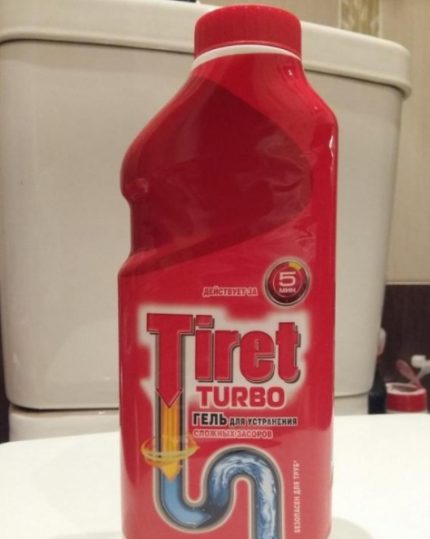
Advantages:
- eliminates unpleasant odors;
- dissolves organic matter;
- disinfects plumbing;
- Convenient packaging with a lid-lock.
Disadvantages:
- high price;
- Does not cope with complex traffic jams;
- pungent odor;
- uneconomical.
Method of application: the right amount of gel is poured into the toilet drain hole (it is better to completely trap the accumulated liquid). After a 30-minute wait, the drain is rinsed with water supplied under pressure.
Chirton "Clean Gutters." Granular agent including caustic soda, sodium nitrate. A relatively safe and effective drug, which is packaged in disposable bags.
Advantages:
- well dissolves the majority of pollution;
- lack of dust;
- safety for drains;
- affordable price;
- quick result.
Minuses:
- rarely found on sale.
Method of application: granules are poured into the outlet pipe of the toilet bowl, left for 15 minutes, after which the system is washed well with water. When used, a pungent odor appears that quickly disappears.
Sanoks “Net stock”. The tool is in the form of a gel containing sodium hydroxide and approximately 30% surfactant. Well suited for the prevention and elimination of small blockages.
Advantages:
- safe for various types of pipes and sewer systems;
- budget cost;
- convenient cover (there is protection against children).
Disadvantages:
- low cost (packaging is enough for two times);
- does not cope with severe congestion.
Method of application: the right amount is poured into the drain hole, the specified time is maintained (15-30 minutes), and then drained with hot water.
"Flup". The composition of this drug includes caustic soda and sodium carbonate. Two versions of this product are available: with pouring cold or hot water. The latter option is more effective.
Advantages:
- Efficiency - Floop ”copes with such pollution as limescale, feces, collagen fibers, fat;
- convenient packaging;
- elimination of unpleasant odors;
- quick result.
Disadvantages:
- relative high cost;
- the possibility of a chemical burn, which is why when using this drug it is required to protect the respiratory system, hands, eyes, taking appropriate safety measures.
Method of application: granules are poured into the drain, aged 15-30 minutes, after which cold / hot water is poured (depending on the type of product). Then the system is washed with a large amount of liquid.
"Mole". A popular product containing hydroxides of sodium, potassium, surfactant, acetic acid. The drug is suitable for regular care of sewers, copes with light blockages.
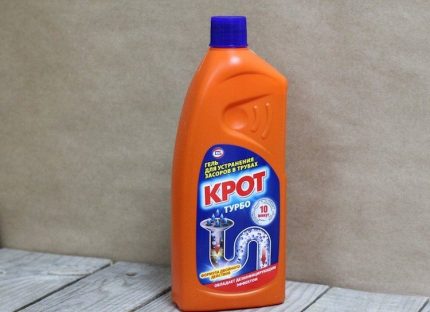
Advantages:
- low price;
- availability.
Disadvantages:
- uncomfortable bottle without blocking from children;
- slow action.
Method of application: 40-120 ml of the composition must be poured into the drain hole, left for 2-3 hours, then rinse the pipes well with water. Since “Mole” is produced by different manufacturers, its properties and instructions for use may vary slightly.
Effective remedies for blockages in sewer pipes and tips for their selection are given in this article.
Mechanical methods of dealing with congestion
More effective methods that can cope with complex traffic jams are different types of mechanical devices.
Plunger - a device to eliminate blockages
A popular plumbing tool consisting of a rubber suction cup and a wooden or plastic handle. The mechanism of operation of the plunger is similar to the action of the pump. The toilet drain is covered by a valve, and then reciprocating movements are made with the pressure on the handle.
Due to this, hydraulic stress is created in the system, as a result of which water and sewage are pumped out of the siphon or pipe, and the existing “plugs” are destroyed. For the best effect, it is advisable to first pour out all the water that has accumulated in the toilet bowl and only then start working as a plunger.
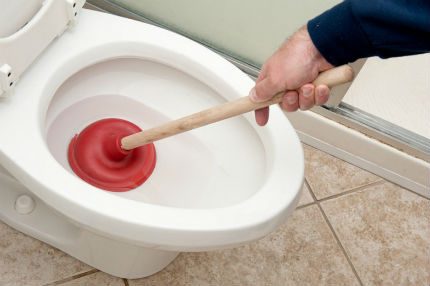
In case of complex blockages, it is advisable to close the drain holes (upper, lower) in all plumbing devices located in the bathroom, in the kitchen, and only then with sharp shocks to pump water in the bowl with a plunger.
If a slow drain is characteristic both in the toilet and in the sink with a washbasin, it is advisable to repeat this procedure separately for each device, blocking the holes in the rest of the plumbing.
After eliminating the “plug” for prevention and disinfection, you need to flush the toilet, pouring 1-2 buckets of warm water into the drain with the addition of soda. The plunger must also be thoroughly washed or placed in a disinfectant solution.
Cable - a tool for solving complex problems
One of the most effective ways to clean a clogged system and toilet is plumbing cableused by both amateurs and professionals. This is a metal cable with a rotating handle.
The tool has various modifications (rope, spring, spring-wound), the length of which can vary between 1.5-60 m.
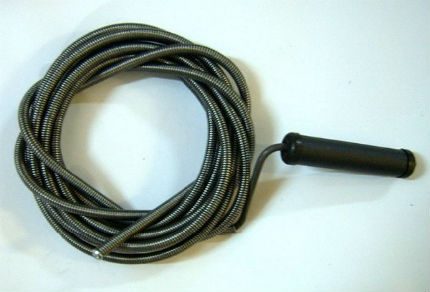
At the end of the cable, a pointed nozzle, a metal brush or a wire spiral is fixed, especially to destroy the blockage. The cable is released into the toilet until it stops and the handle is rotated clockwise, so that the device passes into the water lock.
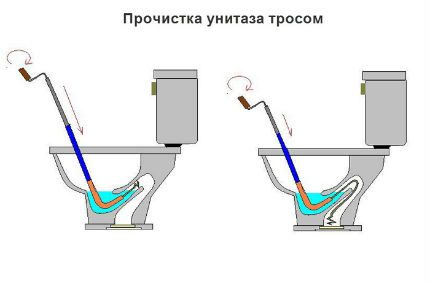
If an obstacle is detected, several cable cleaning methods:
- With a partial immersion of the cable in water, it can abut against the back of the dish bowl. In this case, it is necessary to make pushing movements until the tool slides along the inner surface of this zone of the toilet.
- If during the movement the cable stumbles upon the vertical wall of the riser, you must use special equipment.
- In a toilet with a direct outlet, the cable is pushed through a horizontal sewer pipe until it touches the inside of the riser. If you feel difficulty in moving, then his tip came across a blockage. Then it is worth performing back-and-forth movements, pushing the tool into the riser.
It is most convenient to work with a cable in pairs, which allows better control of the process. Upon completion of the manipulations, the system should be cleaned by washing it well with water, and the instrument should be sanitized.
Handicraft Devices
If there are no special devices in the house, you can use a plastic bottle from drinks or other home-made devices.
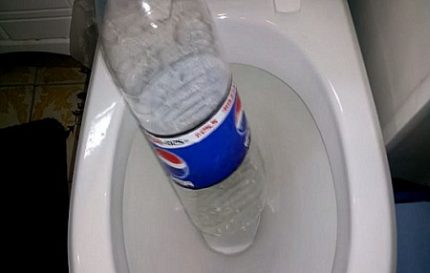
In the first case, the cap is screwed tightly on a regular plastic bottle and the bottom is cut off. Then this device is used similarly to a plunger. After use, the homemade device must be discarded immediately.
You can also make a stick-doll from a stick and unnecessary rags, with which you try to "knock out" a blockage. Alternatively, it is possible to quickly make a homemade plunger from a children's rubber ball, cut in half and fixed on the handle.
Manual drainage
Not too pleasant, but in some cases a necessary option. Typically, this method is used if the owners know that the congestion in the toilet is caused by the ingress of an object (a child’s toy, an apple).
You will have to put on rubber gloves and scoop out the contents of the bowl, and then try to find the object with your hand, which can be pulled out with your fingers or wire, the end of which is bent by a hook.
It is dangerous to use the plunger, since it will only clog the item deep into the sewer system, from where it will be difficult to get it.
Prevention of sewer congestion
Clogging is a very unpleasant thing that is easier to prevent than to deal with it.
For prevention, it is important to constantly monitor the condition of the drainage system:
- Avoid the appearance of rust, salt and other deposits, for which regular cleaning of the bowl and, as far as possible, pipes using modern disinfectants.
- It is imperative to regularly clean the bowl and toilet drain using a plumbing brush.
- Do not throw foreign objects or cat litter into the toilet.
- Do not allow various types of construction debris to get into the sewer system during repair work.
- When installing equipment use sewer pipes desired diameter.
Subject to all these rules, the likelihood of clogging will decrease significantly.
Conclusions and useful video on the topic
From the video you will learn how to clean the pipes and the clogged toilet:
If you are unable to eliminate the cause of the blockage yourself, it is important to contact a plumber immediately.To eliminate complex blockages of sewer systems, special knowledge, skills and professional equipment are required.
Trying to fix a similar problem yourself? Offer an effective solution to the issue, share your experience in dealing with blockages in the toilet. You can leave comments on the article and ask questions in the form below.

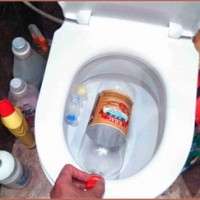 How to clean the toilet with a bottle: step-by-step installation + an overview of alternative methods
How to clean the toilet with a bottle: step-by-step installation + an overview of alternative methods 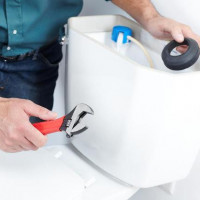 The toilet is leaking after flushing: possible causes of the malfunction and how to eliminate them
The toilet is leaking after flushing: possible causes of the malfunction and how to eliminate them 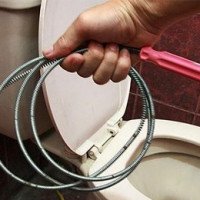 How to clean the toilet bowl with a cable: choosing a tool and instructing on its use
How to clean the toilet bowl with a cable: choosing a tool and instructing on its use 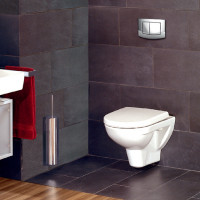 Repair of the installation for the toilet: possible malfunctions and methods for their elimination
Repair of the installation for the toilet: possible malfunctions and methods for their elimination 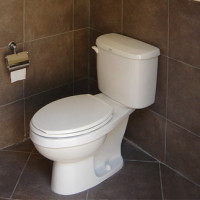 How to eliminate a leak in the toilet: determining the cause of the leak and how to fix it
How to eliminate a leak in the toilet: determining the cause of the leak and how to fix it 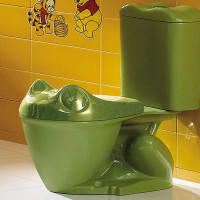 What to do if the drain tank does not hold water: causes and methods for troubleshooting
What to do if the drain tank does not hold water: causes and methods for troubleshooting  How much does it cost to connect gas to a private house: the price of organizing gas supply
How much does it cost to connect gas to a private house: the price of organizing gas supply  The best washing machines with dryer: model rating and customer tips
The best washing machines with dryer: model rating and customer tips  What is the color temperature of light and the nuances of choosing the temperature of the lamps to suit your needs
What is the color temperature of light and the nuances of choosing the temperature of the lamps to suit your needs  Replacement of a geyser in an apartment: replacement paperwork + basic norms and requirements
Replacement of a geyser in an apartment: replacement paperwork + basic norms and requirements
An impressive variety of ways to eliminate blockage in the toilet, especially with improvised means. We always used a plunger and some chemicals. It would be very useful for management companies to conduct mandatory discussions with owners regarding the prevention of sewage blockages, perhaps these measures would partially solve this very important problem.
Many have encountered blockages in the toilet, including myself. When there was no plunger at hand, I had to use one of the above methods - just the same plastic bottle. Unusual, and yet, in my opinion, the bottle is less effective in eliminating blockage, in contrast to the saving plunger. Chemicals are one of the best ways, but with the advent of the child, I had to give it up.
The article is old ... Now there is a Rigger spiral, and not even a word about it.